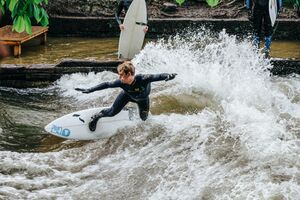Most Continuous Movements Occur Rapidly and Are Referred to as Open loop Movements
Introduction [edit | edit source]

Motor skills are tasks that require voluntary control over movements of the joints and body segments to achieve a goal eg riding a bicycle, walking, surfing, jumping, running, and weightlifting. The learning and performance of these skills are what movement scientists refer to as motor learning and control, or skill acquisition. The the study of motor learning and control plays an integral role in both the performance and rehabilitation of these skills. eg in stroke or total knee arthroplasty rehabilitation.[1]
According to Roller et al (2012) the production and control of human movement
- Is a process that varies from a simple reflex loop to a complex network of neural patterns that communicate throughout the Central Nervous System (CNS) and Peripheral Nervous System (PNS).[2]
New motor patterns are learned through movement, interactions with rich sensory environments, and challenging experiences that challenge a person to solve problems they encounter. The knowledge about motor control and motor learning shape our understanding of how individuals progress from novice to skilled motor performance throughout the lifespan. This page provides an overview about Motor Control and Motor Learning.
Motor Control [edit | edit source]
Definition [edit | edit source]
Motor Control is defined as the process of initiating, directing, and grading purposeful voluntary movement[3]. Shumway-Cook has defined motor control as the ability to regulate mechanisms essential to movement[4].
How does it work? [edit | edit source]

The Motor Control functions in the following way:
- The task that needs to be completed is identified→ body gathers sensory information from the environment→ perceives the information→ chooses a movement plan appropriate plan to meet the goal of the task,
- Plan is coordinated within the CNS → executed through motor neurons in the brain stem and spinal cord → outcome communicated to the muscles in postural and limb synergies, and in the head and neck→ motor units timed to fire in a specific manner.
- Sensory feedback supplied to the CNS by the movement → decision taken to (1) modify the plan during execution, (2) acknowledge the goal of the task to be achieved, and (3) store the information for future performance of the same task-goal combination[2].
Theories of Motor Control [edit | edit source]
The organization and production of movement is a complex problem, so the study of motor control has been approached from a wide range of disciplines, including psychology, cognitive science, biomechanics and neuroscience. The control of human movement has been described in many different ways with many different models of Motor Control put forward throughout the 19th & 20th Centuries. There is still a considerable lack of knowledge which details exactly what is acquired during skill acquisition and which practices are best in order to develop these skills[1].
Motor Control Theories include the production of reflexive, automatic, adaptive, and voluntary movements and the performance of efficient, coordinated, goal-directed movement patterns which involve multiple body systems (input, output, and central processing) and multiple levels within the nervous system. Many textbooks and researchers recommend adoption of a systems model of Motor Control incorporating neurophysiology, biomechanics and motor learning principles (learning solutions based on the interaction between the patient, the task and the environment). It is imperative to be aware of the effect this relationship between the task and environment when planning our interventions so as to enable our patients to achieve their goals.[5][2]
Motor Control Theories are[4]:
| MOTOR CONTROL THEORIES | AUTHOR | DATE | PREMISE | CLINICAL IMPLICATIONS |
| Reflex Theory | Sherrington | 1906 |
|
|
| Dynamical Systems Theory | Bernstein Turvey Kelso & Tuller Thelen | 1967 1977 1984 1987 |
|
|
| Hierarchical Theories | Adams | 1971 |
|
|
| Motor Program Theory | Schmidt | 1976 |
|
|
| Ecological Theories | Gibson & Pick | 2000 |
|
|
| Systems Model | Shumway-Cook | 2007 |
|
|
Systems Involved in Motor Control [4]
| Sensory/ Perceptual System | Action Systems |
|---|---|
| Somatosensory | Motor Cortex |
| Visual | Basal Ganglia |
| Vestibular | Cerebellum |
| Central Pattern generators |
Motor Learning [edit | edit source]
Definition [edit | edit source]
- "The process of acquiring a skill by which the learner, through practice and assimilation, refines and makes automatic the desired movement"[2].
- "An internal neurologic process that results in the ability to produce a new motor task"[3].
- "A set of internal processes associated with practice or experience leading to relatively permanent changes in the capability for skilled behavior"[6]
Theories of Motor Learning [edit | edit source]
Motor learning is a complex process occurring in the brain in response to practice or experience of a certain skill resulting in changes in the central nervous system. It allows for the production of a new motor skill. It often involves improving the smoothness and accuracy of movements and is necessary for developing controlled movement and calibrating simple movements like reflexes.
Motor learning research considers variables that contribute to motor program formation (i.e., underlying skilled motor behaviour), the sensitivity of error-detection processes, and strength of movement schemas. Motor learning requires practice, feedback and knowledge of results[5][2].
The Motor learning theories are:
| MOTOR LEARNING THEORY | AUTHOR | DATE | PREMISE | CLINICAL IMPLICATIONS |
| Adams Closed Loop Theory | Adams | 1971 |
|
|
| Schmidt's Schema Theory | Schmidt | 1975 |
|
|
| Ecological Theory | Newell | 1991 |
|
|
Stages of Motor Learning [edit | edit source]
According to Fitts and Posner Model[7]:
| Stages of Learning | Characteristics | Attention Demands | Activities | Description |
| Cognitive |
|
| Practise sessions are:
| Early Cognitive; Essential Elements were not observed or not present |
| Late Cognitive; Essential elements are starting to appear | ||||
| Associative |
|
|
| Early Associative; Essential elements appear, but not with consistency. |
| Late Associative; Essential elements appear regulalry at a satisfactory level. | ||||
| Autonomous |
|
|
| Early Autonomous; Essential elements appear frequently avove required level. |
| Late Autonomous; Essential elements appear continuously at a superior level. |
According to Bernstein's Model:
underlines degrees of freedom (the number of independent movements needed to complete an action, as a central component of learning a new motor skill). It has 3 stages. They are[8]:
| Stage | Description |
|---|---|
| Initial | individual simplifies movements by reducing the degrees of freedom |
| Advanced | individual gains a few degrees of freedom, which permits movement in more of the articulations involved in the task |
| Expert | possesses all the degrees of freedom to carry out the task in an effective and coordinated manner. |
According to Gentile's Model:
There are 2 stages in this Model. They are[9]:
| First Stage | Second Stage |
|---|---|
|
|
Factors affecting Motor Learning [10] :
- Verbal instructions
- Practice
- Active participation and motivation
- Possibility of errors
- Postural control
- Memory
- Feedback
Clinical Significance of motor control and learning [edit | edit source]
Motor control and learning help therapists to understand the process behind movements, motor tasks and skills. By acknowledging the theories of motor learning and control and integrating them into day- to-day practice, therapists will have a better chance of:
- identifying issues in motor performance,
- developing treatment strategies to help patients remediate performance problems, and
- planning programmes that include a new movement, or the reacquisition and/or modification of movement to be taught in such a way that it is, consistent and transferrable (ability to perform movement under different environments and conditions).
- evaluating the effectiveness of intervention strategies employed
It is important that therapists identify the appropriate motor learning strategy and motor control theory to get optimal and effective results[2] [4].
Presentations [edit | edit source]
- Essential Concepts of Motor Control & Learning: Presentation by DM McKeough.
Podcasts [edit | edit source]
- Motor Learning Strategies Applied to Neurorehabilitation. Dr. Joe Hidler, CEO of Aretech and inventor of the ZeroG Gait and Balance Training System discusses the research he and colleagues have done which has served as the catalyst as to why ZeroG was developed.
- Making Sense of Sensory and Motor Control of Human Movement.Dr. Kristen Pickett is an Assistant Professor in the Occupational Therapy Program within the Department of Kinesiology at the University of Wisconsin, Madison. She received her Masters in Kinesiology and her PhD in Kinesiology, Biomechanics, and Neural Control from the University of Minnesota, Twin Cities.
| [11] | [12] |
| [13] | [14] |
References [edit | edit source]
- ↑ 1.0 1.1 Science for Sport Skill Acquisition Available: https://www.scienceforsport.com/skill-acquisition/ (accessed 4.10.2021)
- ↑ 2.0 2.1 2.2 2.3 2.4 2.5 Umphred, Darcy A. Umphred's Neurological Rehabilitation. 7th edition. St. Louis, Mo: Elsevier/Mosby, 2013.
- ↑ 3.0 3.1 Medical Dictionary for the Health Professions and Nursing. (2012). Retrieved March 11 2016 from http://medical-dictionary.thefreedictionary.com/motor+learning
- ↑ 4.0 4.1 4.2 4.3 Shumway-Cook A, Woollacott M. Motor Control: Translating Research into Clinical Practice. Philadelphia: Lippincott Williams & Wilkins, 2007. Print.
- ↑ 5.0 5.1 Bate P. Motor Control. In: Sheila Lennon & Maria Stokes. Pocketbook of Neurological Physiotherapy. Churchill Livingstone, 2008. p31 - 40.
- ↑ Krakauer JW. Motor learning: its relevance to stroke recovery and neurorehabilitation. Curr Opin Neurol. 2006 Feb;19(1):84-90. doi: 10.1097/01.wco.0000200544.29915.cc. PMID: 16415682.
- ↑ Fitts PM, Posner MI. Human Performance. Brooks/Cole Pub. Co; Belmont, CA: 1967.
- ↑ Bernstein N. The co-ordination and regulation of movements. The co-ordination and regulation of movements. 1966.
- ↑ Gentile AM. A working model of skill acquisition with application to teaching. Quest. 1972 Jan 1;17(1):3-23.
- ↑ Cano-de-la-Cuerda R, Molero-Sánchez A, Carratalá-Tejada M, Alguacil-Diego IM, Molina-Rueda F, Miangolarra-Page JC, et al. Teorías y modelos de control y aprendizaje motor. Aplicaciones clínicas en neurorrehabilitación. Neurología. 2015;30:32–41. https://www.elsevier.es/en-revista-neurologia-english-edition--495-articulo-theories-control-models-motor-learning-S2173580814001424
- ↑ Dr, Richard Keegan. Lecture 1 Classifying Skills and Abilities. Available from: https://www.youtube.com/watch?v=wlvh8mxxsr4 [last accessed 01/03/16]
- ↑ Dr, Richard Keegan. Lecture 2 Conceptualising Motor Learning. Available from: https://www.youtube.com/watch?v=NOthWZhdXVE [last accessed 01/03/16]
- ↑ Dr, Richard Keegan. Lecture 3 Models of Motor Learning Stages. Available from: https://www.youtube.com/watch?v=i8xeLsfigGs [last accessed 01/03/16]
- ↑ Dr, Richard Keegan. Lecture 4 Structuring the Learning Experience. Available from: https://www.youtube.com/watch?v=8OvZpBdyPFo [last accessed 01/03/16]
Source: https://www.physio-pedia.com/Motor_Control_and_Learning
0 Response to "Most Continuous Movements Occur Rapidly and Are Referred to as Open loop Movements"
Post a Comment